Multicomponent Particle Type for Droplets, CFD Simulation Ansys Fluent Training
$180.00 Student Discount
In this project, multicomponent particle type for the droplets has been simulated, and the results of this simulation have been investigated.
Click on Add To Cart and obtain the Geometry file, Mesh file, and a Comprehensive ANSYS Fluent Training Video.To Order Your Project or benefit from a CFD consultation, contact our experts via email ([email protected]), online support tab, or WhatsApp at +44 7443 197273.
There are some Free Products to check our service quality.
If you want the training video in another language instead of English, ask it via [email protected] after you buy the product.
Description
Multicomponent Particle Project Description
In this project, the Multicomponent particle type for droplets has been investigated by Ansys Fluent software. We used the one-way DPM to simulate the discrete phase.
Geometry & Mesh
The 3D geometry of this project has been produced with Spaceclaim software. The length of the computational area is 100 mm, and its height & width is 20 mm.
Mesh is created with Ansys Meshing software and the mesh type is unstructured. The number of cells is 56245.
CFD Simulation
To simulate the present model, we consider several assumptions:
- The solver is pressure-based.
- The current simulation is unsteady in terms of time.
- We ignored the gravity effect.
Here is a summary of the steps for defining the problem and its solution in the following table:
| Models | |||
| Viscous model | K-w SST | ||
| Discrete phase | on | ||
| particle treatment | unsteady particle tracking | ||
| material in injection | Hydrogen_peroxide_water | ||
| particle type in injection | multicomponent | ||
| injection type | cone | ||
| Boundary conditions | |||
| Inlet | Draying_air | Velocity inlet | |
| velocity magnitude | 0.2m.s-1 | ||
| discrete phase BC type | Escape | ||
| Thermal | 450k | ||
| Outlet | Pressure outlet | ||
| gauge pressure | 0Pascal | ||
| discrete phase BC type | escape | ||
| walls | Wall | ||
| wall motion | stationary wall | ||
| discrete phase BC type | reflect | ||
| Solution Methods | |||
| Pressure-velocity coupling | simple | ||
| Spatial discretization | pressure | second-order | |
| momentum | second-order upwind | ||
| Modified turbulent viscosity | first-order upwind | ||
| Initialization | |||
| Initialization method | hybrid | ||
Multicomponent particle Results
In this simulation, which is injected by an injector droplet of two mixed species, which is water and hydroperoxide, the type of evaporative water is defined and the second type without evaporation is considered for this reason. As it is clear from the results, the evaporation of a species can be seen in the droplets, and the decrease in the diameter of the droplets can be seen.
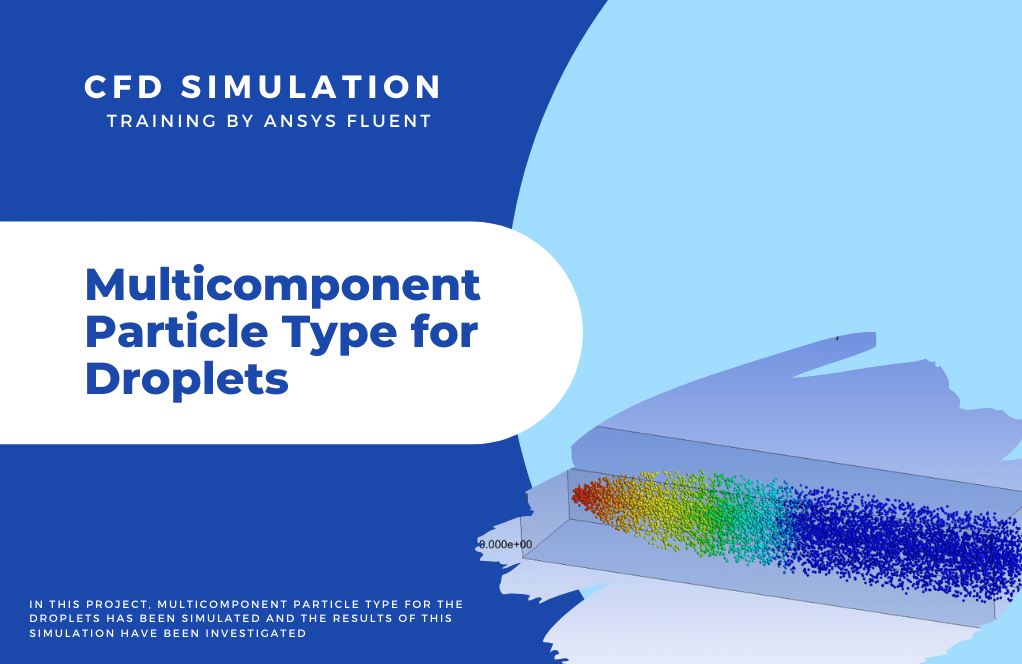

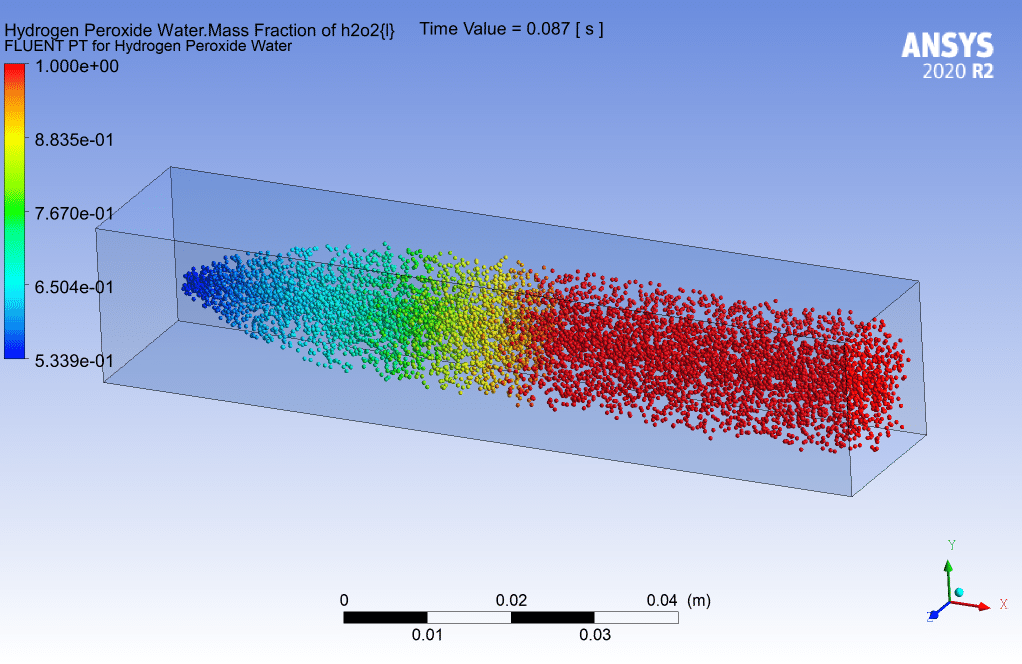
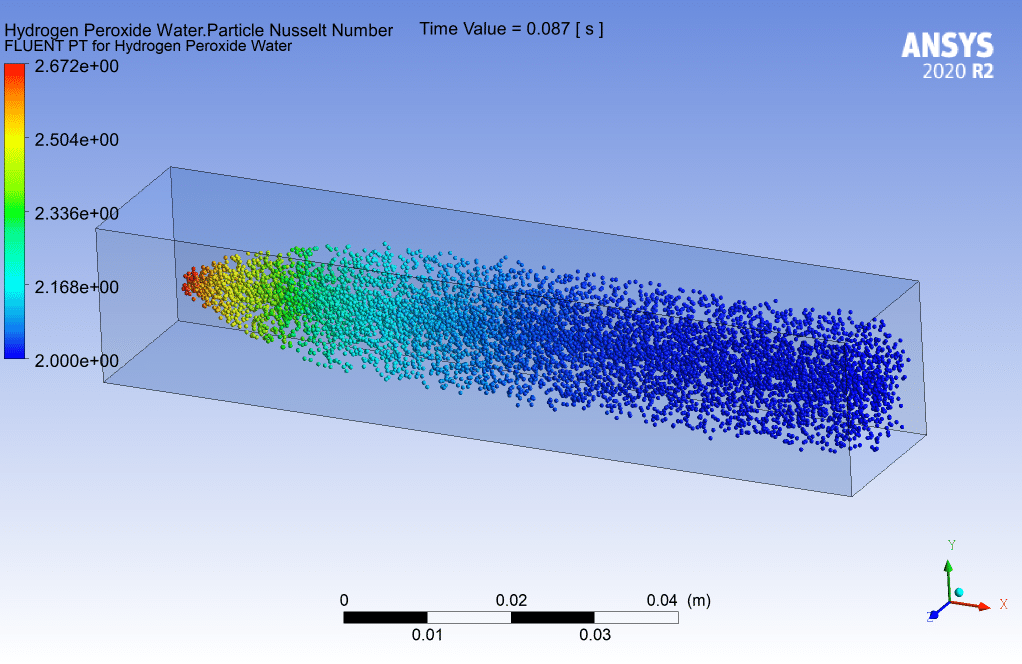

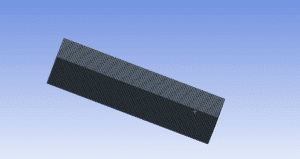

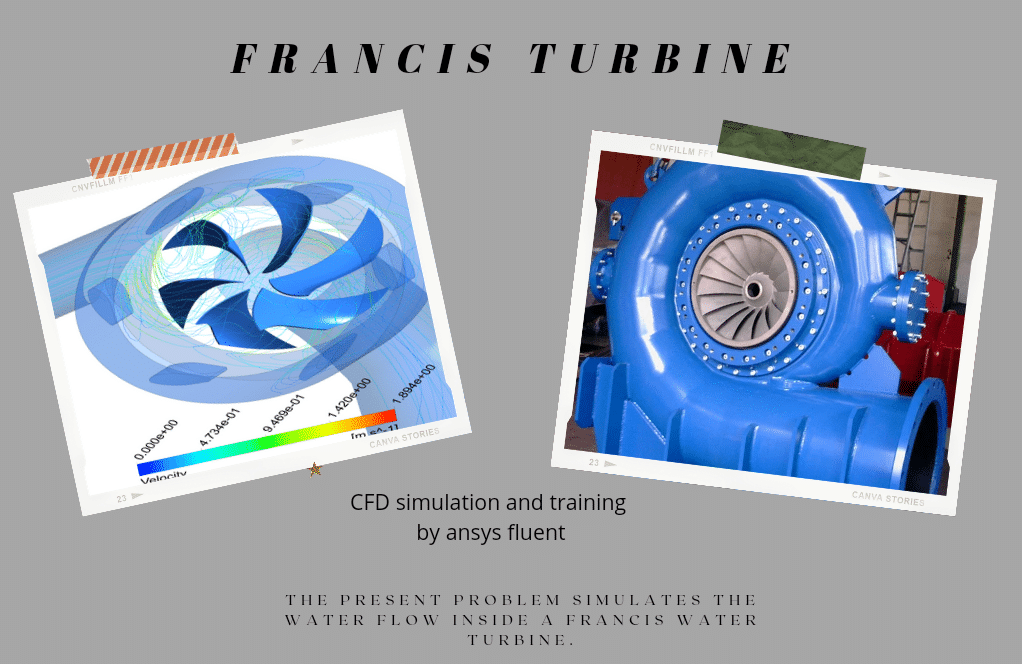

Ashley Daniel –
I’m impressed with the detail of the Multicomponent Particle Type for Droplets simulation. Did the modeling take into account any potential reactions between the water and hydrogen peroxide, or was it simply a physical evaporation process being observed?
MR CFD Support –
The simulation focused primarily on the physical evaporation process of the droplets. The effects of any chemical reactions between the water and hydrogen peroxide were not accounted for in this particular model. The evaporation modeled was of a purely physical nature, tracking the decrease in droplet diameter due to evaporation.
Frieda Baumbach –
I’m really impressed with the detailed simulation of multicomponent particle dynamics using Ansys Fluent. It seems like a robust study for understanding the behavior and evaporation of droplets. Thanks for the comprehensive tutorial!
MR CFD Support –
We’re thrilled to hear you found the tutorial on simulating multicomponent particle dynamics insightful and useful. Your satisfaction is our top priority, and we aim to provide educational resources to help deepen your understanding of CFD analysis. Thank you for taking the time to share your positive feedback!
April Hagenes Jr. –
The injection type is mentioned as ‘cone’. Can you explain what ‘cone injection’ means and how it affects the simulation of multicomponent droplets?
MR CFD Support –
Cone injection refers to a method of introducing particles or droplets into the simulation with a predetermined angle, creating a conical shape of injection. This type of injection is commonly used when the particles are not being released from a single point, but rather a circular area, similar as the nozzle’s spray. For multicomponent droplets simulation, it influences the initial distribution and trajectory of the droplets and ensures a more realistic representation of how they interact with the airflow and undergo processes like evaporation.
Gretchen Kilback –
This looks like a precise study of multicomponent droplets. I’m curious to know more about how the software handles the process of evaporation for the mixed species within the droplets.
MR CFD Support –
Ansys Fluent tracks the droplets through the domain and applies mass and heat transfer calculations based on local conditions on the progress of evaporation. Depending on the properties of the species involved (like water and hydroperoxide in this study), Fluent uses species transport and phase change models to predict the rates of evaporation for each component of the droplet.
Nicholas Kassulke –
What settings were chosen for the DPM and particles, and why was gravity ignored in this simulation?
MR CFD Support –
In this simulation, the Discrete Phase Model (DPM) settings were chosen to reflect a one-way coupling interaction where the particles do not affect the continuous phase, and unsteady particle tracking is used due to the transient nature of droplet behavior. Multicomponent injection type is used to represent the mix of water and hydrogen peroxide in the droplets. Gravity was likely ignored because the effect of the buoyancy forces compared to the forces of interest, such as those caused by droplet evaporation and the inlet velocity, was small, or to isolate the effects of droplet interaction without being influenced by gravity.
Margot Baumbach –
The results look fascinating. Do you account for different environmental temperatures in the simulation to see how they influence the evaporation rate of the droplets?
MR CFD Support –
In this CFD simulation, the initial and boundary conditions are set based on a chosen environmental temperature. To study the influence of different temperatures on the evaporation rate, separate simulations varying the temperature parameters would need to be conducted. That would allow observing the changes in evaporation rates under those different conditions.
Alva Grady II –
I found the explanation regarding multicomponent injections especially intriguing. It’s fascinating how you can simulate evaporation within the droplets. Well done on such detailed work!
MR CFD Support –
Thank you so much for your positive feedback! We’re delighted to hear that our explanation on multicomponent injections and the evaporation simulation was clear and comprehensive for you. If you have any further questions or need more information on CFD simulations, feel free to reach out to us!
Eusebio Lang –
I’m impressed by the detailed set-up for the multicomponent droplet simulation in Ansys Fluent. The clarification of boundary conditions and the choice to use an unsteady DPM really layer complexity onto the simulation. It seems very comprehensive
MR CFD Support –
Thank you for your positive feedback! We are delighted to hear that you appreciate the complexity and thorough setup of our multicomponent droplet simulation. If you have any more questions or need further assistance with similar simulations, please let us know!
Breana Runolfsdottir –
I just finished going through the Multicomponent Particle Type for Droplets CFD Simulation Ansys Fluent Training and I’m totally satisfied! The clarity of the geometry & mesh explanations, the detailed breakdown of the models, and the concise summary of the boundary conditions and solution methods were top-notch. The visualization of droplet behavior, showing evaporation and diameter change, made complex phenomena understandable. Big thumbs up to MR CFD for their excellent work on this simulation!
MR CFD Support –
We are thrilled to hear your wonderful feedback on our Multicomponent Particle Type for Droplets CFD Simulation training! It’s a pleasure to know that the training materials were clear, detailed, and educational, and that they helped in understanding intricate concepts. Thank you for taking the time to review our product. We look forward to providing you with more learning resources in the future!
Tracy DuBuque –
I’m impressed with how detailed the project is. It seems very comprehensive and a great learning experience on multicomponent particle simulations using Ansys Fluent.
MR CFD Support –
Thank you for your positive feedback! We are delighted to hear that you found the project detailed and informative. It’s our goal to provide a comprehensive learning experience, and we’re glad we could meet your expectations.
Brannon Huel –
I’m impressed with the multicomponent particle type simulation. It seems comprehensive. Is it possible to include the gravity effect in this type of simulation, and if yes, how would that affect the results?
MR CFD Support –
Yes, it is possible to include gravity effects in this type of simulation. You would enable the gravity setting in the operating conditions. The inclusion of the gravitational force would typically affect the trajectory and evaporation rate of the particles, making the simulation more realistic, especially if the droplets are expected to behave differently under gravity.
Kassandra Heller –
I’m very impressed with how detailed the modeling process is! Can you provide more information on how the discrete phase refines using unsteady particle tracking and the escape boundary type?
MR CFD Support –
Thank you for your intriguing question! Unsteady particle tracking allows for the detailed simulation of particles over time, capturing transient behaviors and interactions. As particles travel through the computational domain, their paths are calculated dynamically each timestep. The escape boundary condition means that when particles reach the domain’s outlet, they leave the simulation; they’re not reflecting back into the domain or getting trapped. The use of escape in the boundary conditions provides a realistic representation of what would happen as particles exit the real system.
Cristopher Hayes –
Fantastic resource for understanding multicomponent droplet simulations in Ansys Fluent. The step-by-step process laid out was extremely helpful. Appreciated the detailed explanation of different species behaviors, meshing process, and results interpretation.
MR CFD Support –
Thank you so much for your positive review! We’re very pleased to hear that our training material was helpful to you and that the detailed explanations met your needs. If you have any more questions or require further assistance, feel free to reach out.
Roger Macejkovic –
I’m really fascinated by the results section mentioning the evaporative species. Could you please explain how the software differentiates between the two mixed species within the droplets? Does it use different mass transfer models for each component?
MR CFD Support –
In the simulation, the software differentiates between the two mixed species by assigning separate material properties and evaporation models to each. For the water component, an evaporative model is used, allowing the software to track changes in droplet diameter due to evaporation. For the non-evaporative component (hydroperoxide), no such change occurs. The ‘particle type in injection’ set as ‘multicomponent’ in Ansys Fluent allows the software to calculate the evaporation rate based on the surrounding conditions and the properties of each species.
Dr. Jerome Kiehn –
I’m impressed with the level of detail captured in the multicomponent particle simulation training. How accurately does the multicomponent modeling in Ansys Fluent reflect the behavior of hydroperoxide and water mixture in real-world droplet formation and evaporation scenarios?
MR CFD Support –
Thank you for your positive feedback! Our training is designed to closely reflect real-world scenarios. Ansys Fluent uses detailed physical properties and interactions between hydroperoxide and water to simulate droplet behavior. Although simplifications and assumptions are made for computational viability, the software is highly capable of capturing the essential physics guiding droplet formation and evaporation, providing a precise and realistic depiction of multicomponent particle dynamics.
Solon Kiehn –
I was very impressed by the level of detail in the Multicomponent Particle Type for Droplets CFD simulation. The clear breakdown of each step made understanding the process quite intuitive. Utilizing a pressure-based solver and adapting such precise boundary conditions indicates careful planning of the simulation strategy. It’s also notable how you captured the dynamic behavior of mixed species in the droplets, revealing the evaporation process that results in diameter reduction. Excellent work on portraying complex interactions in a comprehensible manner.
MR CFD Support –
Thank you so much for your positive feedback! We’re thrilled to hear that you found the Multicomponent Particle Type for Droplets simulation to be detailed and intuitive. It’s always rewarding to know that our efforts in creating clear, step-by-step CFD simulations are appreciated and understood by our customers. We take pride in portraying complex physical phenomena in an accessible way for learners at all levels. If you have any further questions or need assistance with other simulations, please feel free to reach out to us!
Jacklyn Hagenes I –
I’m amazed by the detail and the unique insights provided in your simulation training. It really helped me understand how different compounds behave in droplet form! Great job on the comprehensive tutorial.
MR CFD Support –
Thank you for your kind words! We’re so glad to hear that our tutorial was able to help you understand the behavior of multicomponent particles in droplets. If you have any more questions or need further assistance in the future, please don’t hesitate to reach out.
Brenden Boyle –
The detail in component interaction is fantastic! It’s impressive to see the evaporation process so well-represented in the results. Great work on the simulation!
MR CFD Support –
Thank you for your kind words! We’re glad that the simulation details met your expectations and that you found the representation of the evaporation process impressive. If you have any more questions or need further assistance, feel free to reach out!